Objectives
|
| < Day Day Up > |
|
It's obvious that you wouldn't have much of a game if you didn't give your players something to strive for. Objectives do just that. They define what players are trying to accomplish within the rules of the game. In the best-case scenario, these objectives seem challenging-but achievable-to the players.
In addition to providing challenge, the objective of a game can set its tone. A game in which the objective is to capture or kill the opponent's forces will have a very different tone from a game in which the objective is to spell more or longer words.
Some games are constructed so that different players have different objectives, while other games allow the player to choose one of several possible objectives. Additionally, there may be partial objectives in a game that help the players to accomplish the main objective. In either case, the objective should be considered carefully because it affects not only the formal system of the game but also the dramatic aspects. If the objective is well-integrated into the premise or story, the game can take on strong dramatic aspects.
Some questions to ask yourself about objectives as you design your own games are:
-
What are some objectives of games you've played?
-
What impact do these objectives have on the tone of the game?
-
Do certain genres of play lend themselves to certain objectives?
-
What about multiple objectives?
-
Do objectives have to be explicit?
-
What about player-determined objectives?
Here are some examples of objectives from games you might have played:
-
Connect Four: Be the first player to place four units in a contiguous line on the playing grid.
-
Battleship: Be the first player to sink all five of your opponent's battleships.
-
Mastermind: Deduce the secret code of four colored pegs in as few steps as possible.
-
Chess: Checkmate your opponent's king.
-
Clue: Be the first player to deduce who, where, and how a murder was committed.
-
Super Mario Bros.: Rescue Princess Toadstool from the evil Bowser by completing all eight worlds (32 levels) of the game, each of which have their own mini-objectives.
-
Spyro the Dragon: Rescue your fellow dragons who have been turned to stone, and defeat the evil Gnasty Gnorc by completing all six worlds of the game, each of which have their own mini-objectives.
-
Civilization: Option 1: conquer all other civilizations on the board, or Option 2: colonize the star Alpha Centauri.
-
The Sims: Manage the lives of a virtual household; as long as you can keep your household alive, you can set your own goals for the game.
Are there any generalizations we can make about types of objectives that might help us in our design process? A number of game scholars have made attempts to categorize games by their objectives-here are some of the categories they defined.[2]
-
Capture
The objective in a 'capture' game is to take or destroy something of the opponent's (terrain, units, or both), while avoiding being captured or killed. Examples of this type of game are strategy boardgames like chess and checkers, as well as action games like Quake, SOCOM II, and their brethren. Also in this category are real-time strategy games like the WarCraft series and Command & Conquer. There are, in fact, so many examples of games with this type of objective that it's difficult to make any generalizations. Suffice to say that the concept of capture or killing the opponent's forces is one that is deeply ingrained in games today and has been since antiquity.
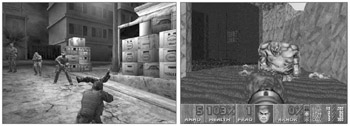
3.11 Capture or kill: SOCOM II and Doom -
Chase
The objective in a 'chase' game is to catch an opponent, or elude one, if you are the player being chased. Examples of chase games include tag, Fox & Geese, Assassin, and Maximum Chase. Chase games can be structured as single player versus game, player versus player, or unilateral competition. For example, tag and Fox & Geese are unilateral competitions, or one player versus many. Assassin is player versus player with each player chasing and being chased simultaneously. And Maximum Chase, an Xbox game, is player versus game, with the player in pursuit of computer- controlled enemy cars. Chase games can be determined by speed or physical dexterity, as in tag and Maximum Chase, or by stealth and strategy, as in Assassin. Also, a game like Scotland Yard, discussed on page 45, is a chase game, but one which is determined by logic and deduction. There is clearly a wealth of possibilities for games using this type of objective.
-
Race
The objective in a 'race' game is to reach a goal-physical or conceptual-before the other players. Examples could be a footrace, a board- game like Uncle Wiggly or Parcheesi, or a simulation game like Virtua Racing. Race games can be determined by physical dexterity, such as with the footrace and, to some extent, Virtua Racing, or chance, such as with Uncle Wiggly and Parcheesi. They can also be determined by a mix of strategy and chance, such as in backgammon.
-
Alignment
The objective in an 'alignment' game is to arrange your game pieces in a certain spatial configuration or create conceptual alignment between categories of pieces. Examples include tic-tac-toe, solitaire, Connect Four, Othello, Tetris, and Bejeweled. Alignment games are often somewhat puzzle-like in that they involve 'solving' spatial or organizational problems in order to achieve the goal. They can be determined by logic and calculation, as in Othello and Pente, or by chance opportunity combined with calculation, as in Tetris and Bejeweled. Conceptual alignment is used in many games that require the players to make 'matches' or 'sets' of game pieces.

3.12 Chase games: Maximum Chase Maximum Chase trademark Microsoft Corporation
3.13 Race games: Pole Position and Gran Turismo 4Pole Position © 1982 Namco Ltd. All Rights Reserved. Courtesy of Namco Holding Corp.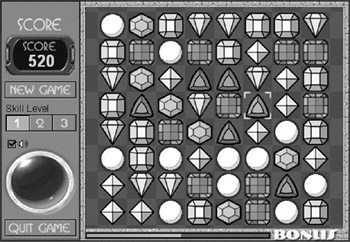
3.14 Alignment: Bejeweled -
Rescue or escape
The objective in a 'rescue' or 'escape' game is to get a defined unit or units to safety. Examples are Super Mario Bros., Prince of Persia 3D, Emergency Rescue: Firefighters, and Ico. This objective is often combined with other partial-objectives. For example, in Super Mario Bros., the overall objective, as mentioned previously, is to rescue the Princess. But each of the game levels also has their own objectives that are more puzzle-like (see 'Solution' on page 58).
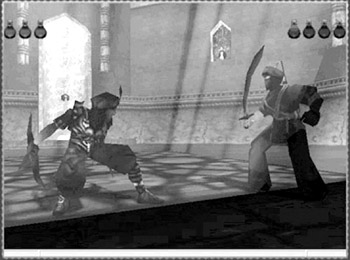
3.15 Rescue or escape: Prince of Persia 3D
6. Forbidden Act
The objective in a 'forbidden act' game is to get the competition to 'break the rules' by laughing, talking, letting go, making the wrong move, or otherwise doing something they shouldn't. Examples include Twister, Operation, Ker-Plunk!, and Don't Break the Ice. This is an interesting game type that isn't often found in digital games; perhaps because of its lack of direct competition or the difficulty in monitoring fair play. From the examples it's clear to see that there is often a physical component to games with this objective, sometimes involving stamina or flexibility, and sometimes just plain chance.

3.16 Forbidden act: Milton Bradley's Operation
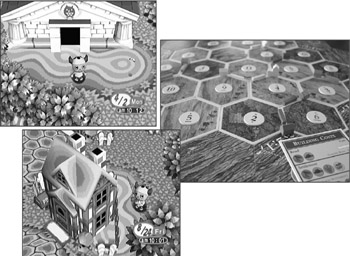
3.17 Construction: Animal Crossing and Settlers of Catan
Not included in the work of the scholars mentioned previously, but interesting nonetheless, are objectives such as the following items.
-
Construction
The object in a 'construction' game is to build, maintain, or manage objects; this may be within a directly competitive or indirectly competitive environment. This, in many instances, is a more sophisticated version of the 'alignment' category. Examples of this type of game are simulation games like Animal Crossing, Gazillionaire, SimCity, or The Sims, or boardgames like Settlers of Catan. Games with a construction objective often make use of resource management or trading as a core gameplay element. They are usually determined by strategic choice making, rather than chance or physical dexterity. Also, construction games can often be left open to player interpretation as to what ultimate 'success' is within the game; so, for example, players choose what type of city to build in SimCity, or household to encourage in The Sims.
-
Exploration
The object in an 'exploration' game is to explore game areas. This is almost always combined with a more competitive objective. In the classic game of exploration, Colossal Cave Adventure, the objective is not only to explore Colossal Cave but also to find treasure along the way. In games like the Zelda series, the objectives of exploration, puzzle- solving, and sometimes combat intertwine to form multifaceted gameplay. Online worlds like Ultima and EverQuest have also used exploration as one of several objectives in their game structures.
-
Solution
The object in a 'solution' game is to solve a problem or puzzle before (or more accurately) than the competition. Examples include graphic adventures like the Myst series, text adventures like the classic Infocom titles, and many games that fall into other categories but have puzzle qualities. These include some we've mentioned already: the Mario and Zelda games, Tetris, and The Sims. Some games of pure strategy fall into this puzzle-like category as well: Connect Four and tic-tac-toe.

3.18 Exploration: Stationfall and The Legend of Zelda: The Wind Waker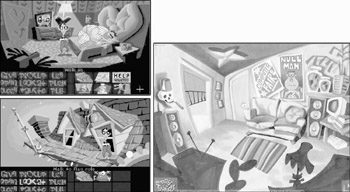
3.19 Solution: Day of the Tentacle -
Outwit
The object in a game of 'wits' is to gain and use knowledge in a way that defeats the other players. Some games of this type focus on having extra- game knowledge, like in Trivial Pursuit or Jeopardy! Others focus on gaining or using in-game knowledge: Survivor and Diplomacy. This second type of game provokes interesting social dynamics, which have yet to be truly explored in digital games.
Summary
This list is by no means exhaustive, and one of the most interesting things about objectives in games is when they are somewhat mixed. For example, the genre of real-time strategies mixes war with construction, forming a split focus that appeals to gamers who might not be interested in either pure war games or pure construction games. What you can do with a list like this is use it as a tool to look at the types of objectives you like in games, as well as those you don't like, and see how you might use these objectives in your own game ideas.
Exercise 3.4: Objectives
List out ten of your favorite games and name the objective for each. Do you see any similarities in these games? Try to define the type or types of games that appeal to you.
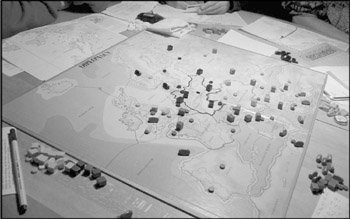
3.20 Outwit: Diplomacy
[2]Adapted from the work of: Fritz Redl, Paul Gump, and Brian Sutton-Smith, 'The Dimensions of Games,' The Study of Games (New York: Robert E. Krieger Publishing, Inc., 1979), pp. 417-418 and David Parlett, The Oxford History of Boardgames (New York: Oxford University Press, 1999).
|
| < Day Day Up > |
|
EAN: 2147483647
Pages: 162
- Chapter VII Objective and Perceived Complexity and Their Impacts on Internet Communication
- Chapter VIII Personalization Systems and Their Deployment as Web Site Interface Design Decisions
- Chapter IX Extrinsic Plus Intrinsic Human Factors Influencing the Web Usage
- Chapter XVI Turning Web Surfers into Loyal Customers: Cognitive Lock-In Through Interface Design and Web Site Usability
- Chapter XVIII Web Systems Design, Litigation, and Online Consumer Behavior